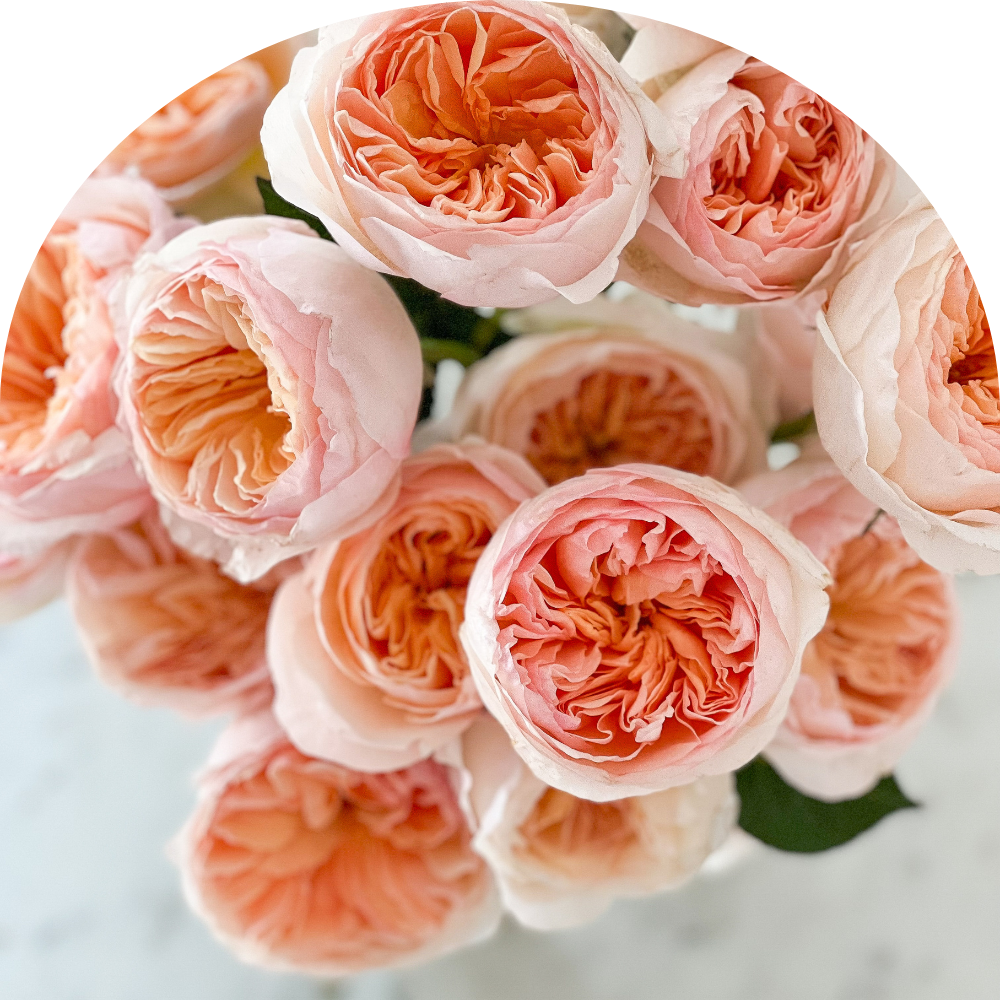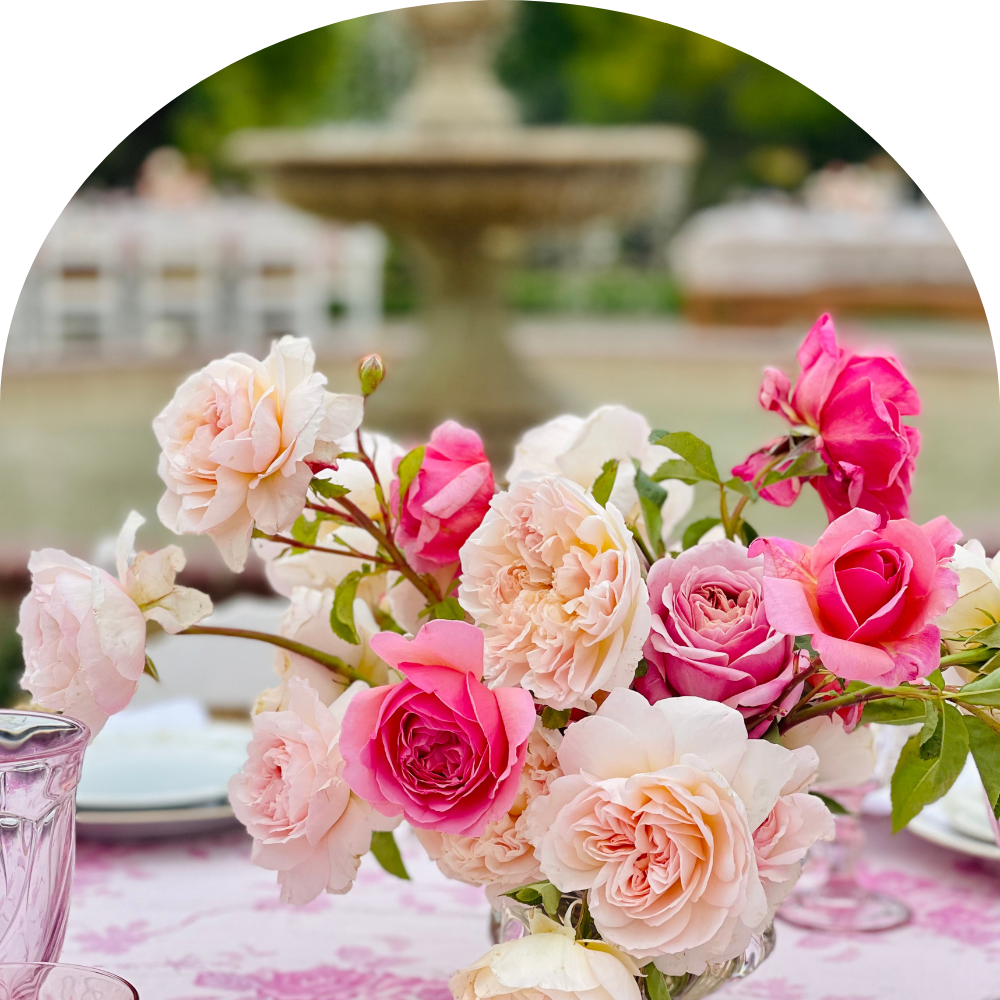Hi Friends! We receive a lot of questions via social media so I'll be choosing five per week to answer on our blog. This week, since it's pruning season for so many of us, I've chosen to answer some questions related to winter rose care and pruning. Please send your questions via social media and I will continue to answer as many as I can! xo
When do you feed your roses after pruning in the winter?
One of the things I enjoy most about winter is seeing the first leaves start to grow on our newly pruned roses. The last week of January and the first week of February is when we really begin to see new growth happen. Today I noticed we have about 1” of new leaves on our roses (so exciting!), so that means it’s time to feed! Once we begin feeding, our roses really take off. We received a good amount of rain this winter (12" in December alone!!), so our soil has been rinsed of buildup and fortified with rainwater. A good rule of thumb is to begin feeding once you see ½” to 1” of new growth on your roses’ canes. You can feed an organic granular fertilizer such as Jobe’s Organics All-Purpose Fertilizer, alfalfa pellets, MaxSea, or really any fertilizer of your choice. Some people prefer granular slow release fertilizers such as MiracleGro or Osmocote and there is no judgment on my part for choosing a synthetic. Sometimes synthetic is what gardeners have time for as it requires less frequent feeding and is more cost effective. We will begin using MaxSea in our fertigation system this week. If we have the manpower, we will put 1 cup of alfalfa pellets at the base of each rose bush. Alfalfa pellets have to be watered in really well and I don’t see rain on the horizon, so we may skip that step. We would need to drag a hose around to thousands of roses, and to be honest, it’s just not worth it for us when we’ve invested in a sophisticated fertilization system. We can add alfalfa tea to our fertigation system, which we may do in early spring! So please start feeding your roses once you see 1/2" to 1" of new growth in the spring!
Do you do preventative spraying for any reason during the wintertime?
We practice routine dormant spraying of our roses in the winter. I detailed the reason for this in our Winter Rose Care Guide, which you can download here! Dormant spraying is a really important part of caring for roses in the off-season, because, in climates such as ours, pests and disease can and will overwinter and cause yucky problems in the spring. By pruning off last year’s growth you are resetting your roses for the new growing season and part of that has to be eliminating problems such as fungal diseases and pests that live in and on our roses. In our Winter Rose Care Guide, there are links to organic products we recommend for keeping your roses healthy in the winter months so they thrive in the spring!
I live in XYZ city. When should I prune my roses?
Rose pruning should take place in very early spring before new growth starts to push from your roses. You will see buds swell on your rose canes, which means your roses are waking up from their winter dormancy. This is the optimal time to start pruning. The pruning process will wake your roses up, but don’t do it too early because if frosts are still part of your late winter forecast, any new growth your roses push as a result of pruning too early can become susceptible to frost damage. Been there, done that! It’s best to wait until after your last frost date or when you see budeyes swelling on your roses’ canes. For those of us in warm climates (zones 9-11) our roses never truly “go to sleep for winter” and you may notice your budeyes swelling on the lower part of your roses’ canes while the tops of your plants are still green or blooming into winter. We have a lot of roses in our landscape right now that are still blooming, but also pushing new growth from the bare canes closer to the ground. In zones 10-11 rose pruning should be done by the end of January so roses flush in early April. For other parts of the country, I have heard of gardeners doing their rose pruning when the forsythia begins to bloom in their area. When I lived in the northeast I loved seeing the vibrant yellow forsythia bloom in late March and early April. It meant winter was over (hallelujah!!) and everything outdoors was coming back to life. What a beautiful time of year and such a simple way to remember to prune your roses!
How do you prune climbing roses? Do you remove all the leaves off of those in zone 10?
Climbing roses are a thing of themselves and I know I haven’t been the best at giving you great information about how to grow them. The reason for that is we don’t actually grow that many climbers - only around 100. We have climbers as ornamental roses at our farm, but we don’t use them for harvesting stems. So how do we prune climbing roses? That all depends on how mature they are and what variety they happen to be. By nature, climbing roses are vigorous. Some of them need to be cut back hard every year because they grow so quickly. For the most part, climbing roses just require routine shaping. This means that we want to tame or trim back any wild canes that are jetting out in a direction not aesthetically pleasing. Climbing roses typically cover an arch or other architectural piece in a garden so if you think of them as ornamental, you really just want to trim them so their shape is pleasing to whatever structure they’re growing on. It’s really that simple!. We want to keep the climbers’ canes moving upwards and over the structure in a direction that allows for airflow and the plants to bloom profusely. So, the way we care for our climbers in the winter is by 1) removing all foliage and 2) gently shaping the rose so all new growth looks well-manicured. Some of our climbers, Sally Holmes, for instance, needs a heavier cutting back because she grows so wild in our climate. Others are simply gently trimmed and then we tuck and weave the long canes into the structure we’ve planted the roses against. I will take some photos of our David Austin climbers and share them on Instagram soon! We have 20 magnificent English roses planted along our three rail fence and I think this coming year they will make huge gains in their growth! And just like all roses, please remove ALL foliage during your pruning.
How long should I wait to harvest roses from a newly planted bare root rose?
Not a winter rose care question, but one we receive so often! I'll explain bare root roses in considerable detail here so you can decide when you should begin harvesting stems from your roses. Bare root roses are typically two years old by the time you receive them. A grower (propagator) plants rootstock in their fields, lets the rootstock mature for several months, and then grafts a scion (budeye) onto the rootstock. The rose is left to mature in the grower’s propagation fields for two seasons. Bare root roses can also be grown as own-root roses, which would mean they are only one year old at the time of harvesting from the propagator's field. Typically roses are dug up in the fall and shipped to customers as early as January for zone 10 and as late as May for zones 3-4. For us, since we are in zone 10, our roses mature VERY quickly. A two-year-old bare root rose that’s planted in our gardens in late winter or early spring will be fully loaded with buds in April. We typically won’t harvest stems from plants that soon though. We go through a process called disbudding which literally means to remove buds from the roses. Removing buds tells the rose bush to put its energy into growing, instead of flowering. Flowering takes a lot of energy from roses, so by removing buds you are sending your roses the message that you want them to push new growth. Routine disbudding for 1-2 bloom cycles (April and May) helps our roses establish strong roots and hearty canes. By June we are usually ready to begin harvesting 12” stems from our rose bushes. Please keep in mind that roses grow faster in California than anywhere else in the US because of our “not too hot” and “not too humid” Mediterranean climate. By mid-summer, our roses look like fully established roses, and truly the only way to know they’re new plants would be to look under their skirt where you’d see canes that aren’t woody yet and are relatively thin. My best advice is to watch your roses for when it’s time to begin harvesting from them. We only cut stems from our roses when we can cut at least a 12” stem and still leave 2-3’ of plant growth. For those of you in cooler climates, it might be best to disbud your roses for a whole season so by the second year in the ground your roses are well rooted and will produce a healthy amount of blooms. It’s really up to you to decide if you want to wait it out for a couple of months like we do or a whole season before you cut stems from your roses. If instant gratification is your thing, by all means, please cut blooms from your roses the first season! Roses are vigorous plants and will surprise you by how much they love to grow and thrive!









